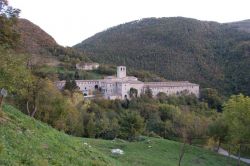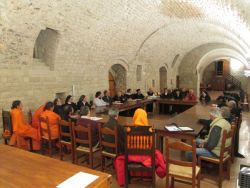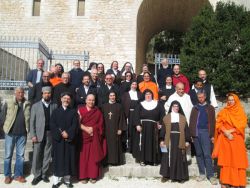Annual meeting of the Italian MID
The Italian group of the Monastic Interreligious Dialogue (MID/DIM) held its annual meeting, this year at the monastery of Fonte Avellana
27 November 2013
On 22–24 October the Italian group of the Monastic Interreligious Dialogue (MID/DIM) held its annual meeting, this year at the monastery of Fonte Avellana. The remote situation of the ancient Camaldolese monastery in the Apennines of Umbria-Marche id not discourage participation, which in fact was greater than last year. The participants numbered thirty-three, two thirds of them Christian monks and nuns (Benedictine, Cistercian, Trappist, Olivetan, Camaldolese, Bose, Poor Clares, and Capuchin nuns) and one-third Hindu, Buddhist (Tibetan and Zen) and Taoist. Present were also an imam of a Sufi Muslim fraternity and a professor expert in inter-cultural and interreligious dialogue. This year the group was especially honored by the presence of fr William Skudlarek, an American Benedictine living in the Fujimi priory in Japan and secretary-general of MID/DIM, and of fr Indunil Janakaratne, under-secretary of the Pontifical Council for Interreligious Dialogue, responsible for relations with Buddhism.
The warm and attentive hospitality of the Fonte Avellana monastic community, thanks especially to the organization contribution of br Cesare Bovineli, one of its monks and a member of MID/DIM, permitted the meeting to be held in a climate of true fraternal friendship and of profound spiritual communion. The prior of Fonte Avellana, dom Gianni Giacomelli, in his words of greeting manifested his and his community’s sensitiveness for interreligious dialogue in the conviction that, as he said, “our interreligiosity is an inter-humanity” and that an inter-monastic meeting “has a prophetic meaning in the world in which we live”.
The sessions were presided by the coordinator of Italian MID/DIM, br Matteo Nicolini-Zani, assisted by its secretary, br Giandomenico Placentino, monks of our Bose monastic community. In his introduction, the coordinator explained the sense, the end, and the modality of the dialogue. Conscious of being called “to become monks in an interreligious way”, the members of the group this year began a common “pilgrimage” to the rediscovery of their specific identities as spiritual seekers and monastics. The itinerary of dialogue, in which they were able to know each other better and in which the specific monastic identity of those present was compared, showing up consonances and dissonances, was carried out in two phases.
The first phase towards discovery “who is the monk?” in the various religions examined the theme: “Monasticism as an anthropological phenomenon”. In this first part reflection centered on the fundamental conviction that monastic life, because it is human life, tends towards developing and perfecting the monk so as to bring him to the maturity proper to man, hence is a school of humanity. If monasticism is a human even before being a religious reality, it has a pre-confessional dimension common to every religious tradition.
The second phase of the dialogue too its impulse from the awareness that, from the strictly lexical point of view, the word “monk” remains fundamentally untranslatable from one religious vocabulary to another. If the participants showed agreement in affirming that the vocabulary is common, that is, all recognize themselves in the word “monk”, nevertheless the meaning of this term is different in each religious tradition. The challenge, hence, was to make evident, beyond the dictionary definition, what the term means concretely in the various religious paths.
The papers prepared as a basis for dialogue in this second phase, using important sources, allowed those present to understand better the identity of the monk in Hinduism, in Buddhism, in Taoism, and in Christianity. Through a lively exchange of questions and in various moments of discussion after each presentation an attempt was made to evaluate the elements that make a monk a monk in the various religions, keeping in mind especially one question: is it possible, and if so how, to arrive at a transversal and shared definition of monk? Celibacy, being on society’s fringes, asceticism, common life — are these elements shared by all monasticism?
Among the many useful things that emerged for future reflection was the conclusion of the participants at the dialogue. “As monastics of different religious traditions, we find that our practices are very similar, as are also our experience and the effects of these practices, but the end, the ends are different. As monastics, then, we travel the same road towards different goals.


